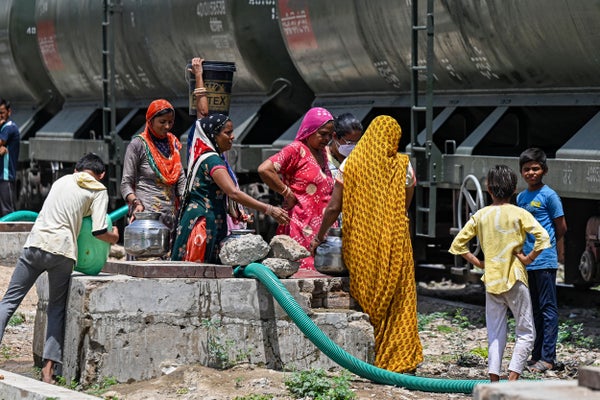CLIMATEWIRE | A heat wave in South Asia last month intensified to record-shattering levels because of climate change.
Global warming made the withering events in India and Bangladesh at least 30 times more likely to occur, according to a new study, and in Thailand and Laos, the extreme heat would have been virtually impossible without the influence of rising temperatures caused by humans.
The findings were reported Wednesday by World Weather Attribution, an international science consortium specializing in the links between climate change and extreme weather events around the world.
On supporting science journalism
If you're enjoying this article, consider supporting our award-winning journalism by subscribing. By purchasing a subscription you are helping to ensure the future of impactful stories about the discoveries and ideas shaping our world today.
The event, which stretched through the second half of April, was one of the most remarkable heat waves to strike South Asia in recent history. Temperatures rose above 105 degrees Fahrenheit across much of the region. Laos recorded an all-time high of 110 F, while Thailand reached an unprecedented 114 F.
Heat index levels — a metric of temperature and humidity — made temperatures feel like 129 F to the human body in parts of central Thailand.
Such levels are “extremely dangerous” for human health, said Chaya Vaddhanaphuti, a scientist at Chiang Mai University in Thailand and one of the study’s authors.
Attribution studies use a combination of observational data and climate models to investigate the influence of climate change on extreme weather events. Models allow scientists to compare the real world with a hypothetical world in which human-caused warming didn’t exist.
In India and Bangladesh, the extreme heat last month wasn’t that unusual. In today’s climate, such an event would have about a 20 percent chance of occurring in any given year.
Still, the study found that climate change made the event about 30 times more likely to occur. And temperatures were about 3.6 degrees Fahrenheit hotter than they would have been without the influence of global warming.
In Thailand and Laos, extreme heat is much rarer. This type of event should only have about a 0.5 percent chance of occurring in any given year, the researchers found. It would have been virtually impossible in a world without climate change.
The heat caused a spike in deaths and hospitalizations, closed schools in some places and made it dangerous for outdoor workers, like farmers, construction workers and street vendors, to do their daily tasks. South Asia is home to some of the world’s most vulnerable populations when it comes to extreme heat, and the impacts of heat waves tend to be unevenly distributed throughout society.
“It is important to talk about factors of age, gender, socioeconomic status, caste, hierarchy in this region that come together that allow people to be able to access certain resources, or disallow them,” said Emmanuel Raju, director of the Copenhagen Centre for Disaster Research at the University of Copenhagen and another study co-author.
Many people in the region live in informal settlements, often with limited access to health care and to fans or other cooling appliances. These populations are among those at greatest risk of illness and death from extreme heat.
People who work outdoors also face dire health risks when extreme heat strikes, he added. That means they may be forced to choose between protecting their health or losing wages.
“It’s important to talk about who can adapt, who can cope and who has the resources to be able to do this,” Raju said.
Expanding the use of heat action plans across South Asia is crucial as global temperatures continue to rise, according to the researchers. Many places already have plans in place, including early warning systems and mechanisms for issuing heat advisories.
However, these systems have “not been uniform," said Anshu Ogra, a public policy expert at the Indian Institute of Technology and a study co-author. And they’re not always designed to reach the most vulnerable communities.
Extreme heat will continue to worsen around the globe until world leaders take sufficient action to curb greenhouse gas emissions. Temperatures worldwide have already warmed to dangerous levels, making it crucial for communities to adapt to the heat even as they work to prevent worse warming in the future, the researchers said.
“Adaptation is not an alternative,” Raju said. “We need to talk about both; we need to talk about mitigation and adaptation as central to these processes to be able to reduce these impacts we see in the world today.”
Reprinted from E&E News with permission from POLITICO, LLC. Copyright 2023. E&E News provides essential news for energy and environment professionals.
